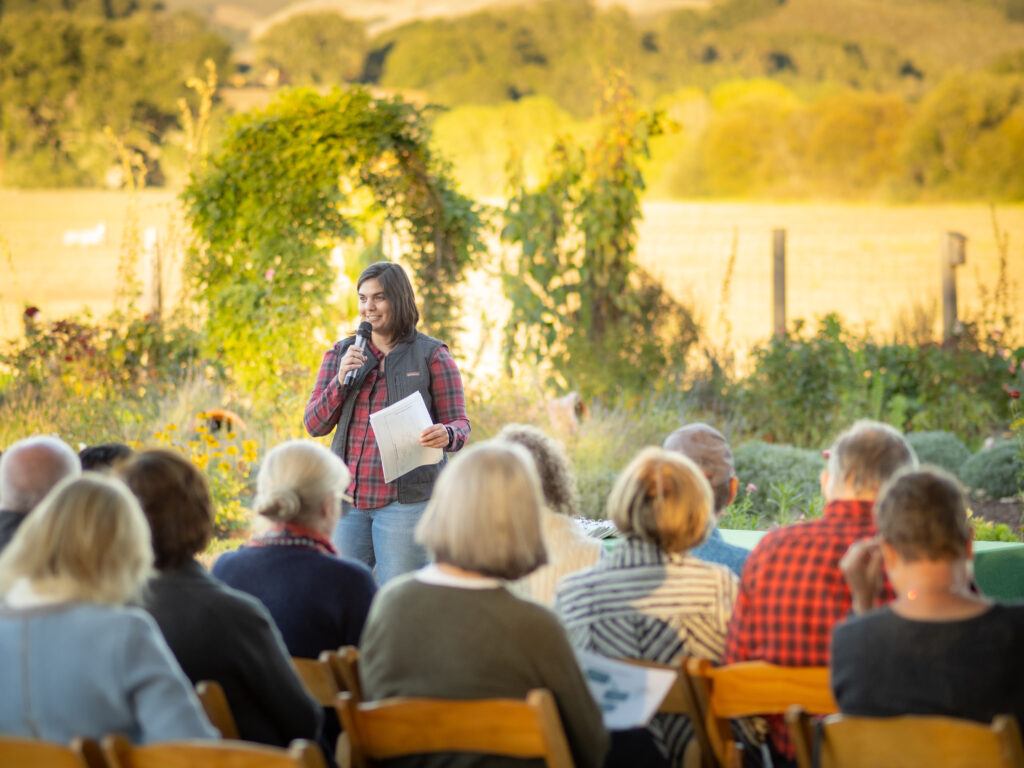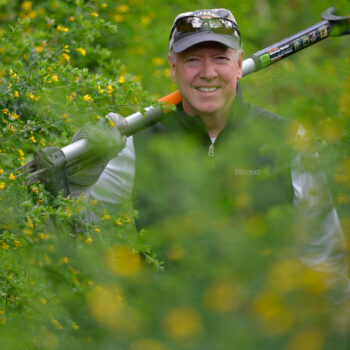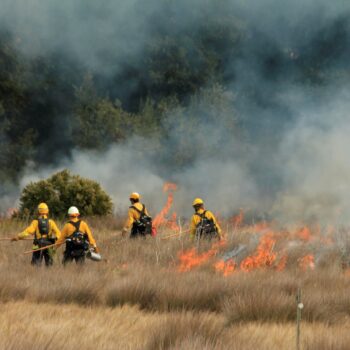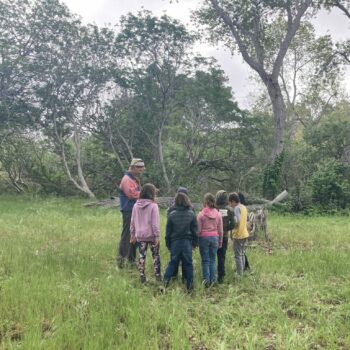

It is with pride and tremendous gratitude that we report on the impact we’ve made together in furthering our mission to protect and steward the unique natural capital of the Santa Lucia Preserve while promoting environmentally sustainable communities. We have you — our amazing community of members, property owners, Preserve entities, agency and foundation partners, and supporters — to thank for every success.
In 2022, together, we:
- Helped make The Preserve a safer place to live by effectively managing fuels and fire risk
- Conserved our region’s unique biodiversity through conservation grazing, invasive species removal, monitoring special-status and keystone species, and collaborating with research institutions, universities, and resource agencies
- Advanced land stewardship through Openlands Management Plans (OMPs), unique experiential events, engaging and informative media, and complimentary technical assistance
- Inspired the next generation of land stewards through our environmental education program serving more than 3,000 kids from Monterey County, including 43% from disadvantaged schools
As we look to the future, we are adapting our strategies to the demands of climate change with a goal to safeguard The Preserve’s resilient biodiversity and wild beauty in perpetuity. Among the first of its kind in the U.S., The Preserve’s thriving conservation community serves as a model across our region and country. Thank you for making our collective vision possible.
With gratitude,
Jamison Watts, Executive Director

Coast redwoods stand in “fairy rings” at the southernmost edge of The Preserve. Photo by Adam White.

Ann Cardone tackles thistle on her Preserve property. Photo by Adam White.
Anne Cardone
Began Openlands Management Plan in 2015
Restoration goals:
- Remove invasive thistles
- Improve grassland soil health through conservation cattle grazing
- Restore bare soil with native bunch grasses and wildflowers
“The thistles are minimal now and we have great wildflowers in the spring,” Anne said.

Kate Kennedy’s stormwater collection tanks at her home on The Preserve. Photo by Joe Fletcher.
Kate Kennedy
Began collecting stormwater in 2012
Water conservation goals:
- Collect 40,000 gallons of rainwater each year
- Irrigate drought-tolerant native landscaping with stormwater alone
“I know I’m going to have to ration the water more and more because the irrigation season has gotten longer,” Kate said.

Matt Himmelman and Rachel Finlay under their favorite oak. Photo by Alix Soliman.
Rachel Finlay & Matt Himmelman
Began Openlands Management Plan in 2020
Restoration goals:
- Restore oak savanna and grassland
- Remove French broom, invasive thistles, and poison hemlock
- Reduce poison oak and coyote brush encroachment
“It didn’t get like this overnight, and we’re not going to get it back to the way it was overnight,” Matt said.
An important part of the Conservancy’s mission to protect and steward The Preserve’s conservation values is mitigating the risk of catastrophic wildfire. In partnership with CSD, landowners, and fire agencies, we accomplish this goal through prescribed burns, grazing and weed management, shaded fuel breaks, and lot-specific fuel management plans (FMPs).
This year, we conducted two successful prescribed burns in our San Francisquito Flats and Dairy Field burn units. To reduce fuel loads in our grasslands, we grazed 121 cattle over more than 1,500 acres. In addition, we conducted a grazing experiment with 800 goats to see if their voracious diet would help us efficiently manage fuels where other methods are infeasible. We found that they require more maintenance and consume the forest understory more nimbly than chaparral.
Thanks to a $1.145 million grant through the RCDMC in 2020, we created 25 miles of shaded fuel breaks along every major road of The Preserve. Lower fuel loads on roadsides will reduce heat and flame length, allowing residents to more safely evacuate and firefighting personnel to aggressively fight a wildfire.

CCPBA members set the San Francisquito Flats ablaze in November. Photo by DMT Imaging.

Valley oak acorns drop into fertile soil after the prescribed burn. Photo by Andrew Evans.

Cattle graze the San Clemente savanna. Photo by Andrew Evans.

The oak woodland understory is managed along Rancho San Carlos road to create a shaded fuel break. Photo by Alix Soliman.

Managed 1,524 acres of grasslands through our conservation grazing program
Removed 681 acres of invasive weeds in grasslands and woodlands
Surveyed 89 wildlife species, including special-staus amphibians, grassland birds, and raptors
Collaborated with NASA, Ventana Wildlife Society, CSUMB, Stanford University, and other research institutions


Started 10 new Openlands Management Plans for a total of 53 OMPs to date
Hosted 19 unique experiential events, from naturalist-guided hikes to catered “garden talks”
Wrote 54 informative blog posts, an engaging monthly e-Newsletter, and a seasonal print newsletter
Provided assistance in tree care, solar development, wildlife management, and restoration to residents


Spent a total of $502,800 on fire and fuel management on The Preserve
Secured another $1.2 million in grant funding from CAL FIRE for fuel break maintenance and access
Created approximately 25 miles of shaded fuel breaks along major roadways
Conducted 2 successful prescribed burns on 85 acres of The Preserve


Served 3,042 students in Monterey County through free outdoor field trips
Taught 127 classes with curriculum including watershed structure, the redwood ecosystem, mammal adaptations, owls, and seasonal change
43% of our classes came from disadvantaged schools and were provided with bussing when needed
Promoted ecological literacy, stewardship, and social-emotional learning

Smith’s Blue Butterfly is a federally endangered sub-species that the Conservancy has been monitoring since 2017. Existing only on the California coast from Monterey to San Luis Obispo County, the butterfly’s main threat is habitat loss. For the Smith’s Blue, habitat means just two plants, coast buckwheat (Eriogonum latifolium) and seacliff buckwheat (E. parvifolium), which this tiny butterfly depends on throughout its life cycle.
This year, thanks to a grant from U.S. Fish and Wildlife Service, we concentrated our efforts on buckwheat recovery. First, by ground-truthing maps from the 1990s and early 2000s, we found that seacliff buckwheat currently covers 118 acres of The Preserve in six priority conservation areas. Then, we created a habitat suitability map that assesses environmental conditions using statistics and remote sensing to forecast where buckwheat could feasibly grow. Using our new maps, we designed tailored restoration plans for each site which include French broom and coyote brush removal, controlled disturbance, and seeding in order to improve habitat for this species teetering on the brink.

Smith’s Blue Butterfly resting on coast buckwheat (Eriogonum latifolium), courtesy of Diane Kodama/USFWS.
The Conservancy partners with California State University, Monterey Bay’s (CSUMB) UROC program to provide mentorship to undergraduate researchers as they develop and implement a scientific field study on The Santa Lucia Preserve. This year, Senior Biology Major Mario Coronado Cartmell worked with SLC’s seasoned ecologists to study the impacts of wildlife disturbance on valley oak (Quercus lobata) regeneration by planting acorns in open and exclosed plots, then capturing herbivory on trail cameras and tracking oak seedling survival.
“I’m grateful for the opportunity to challenge myself with designing my own study,” Mario said. “I’ve learned to think critically about how my methods effect the outcomes of my research and what it takes to have a successful conservation team.” Across California, valley oaks are struggling to establish future generations. Mario’s project seeks to understand at what stage of life — whether it be acorn, seedling, or sapling — these beloved trees are failing to mature. His forthcoming results could have important implications for the restoration of this species.

Dr. Sabine Cudney and Dr. Brian Woodward assist CSUMB UROC undergraduate researcher Mario Coronado Cartmell with establishing study plots. Photo by Alix Soliman.

SLC’s Board of Trustees pictured from left, back row: Scot Smythe, Tom Gray, Kathy Siegel, Jim Andrasick, Paul Kranhold; front row: Rick Werner, Scott Hennessey, Lorraine Yglesias, Cheryl Thiele, Rick Frank.
- Michael Sutton, Chair
- Jim Andrasick, Vice Chair
- Rick Frank, Treasurer
- Lorraine Yglesias, Secretary
- Rick Werner, Preserve Board Rep.
- Buzz Thompson, Sonoran Institute Rep.
- Tom Gray, Emeritus Board Member and Conservancy Founder
- Cheryl Thiele
- Scot Smythe
- Kathy Siegel
- Dr. Bill Shaw
- Rick Rayburn
- Karen Hargrove
- Dr. Andrew Lawson
- Scott Hennessy
- Paul Kranhold
- CAL FIRE
- Carmel River Watershed Conservancy Community Foundation for Monterey County
- Community Fund for Carmel Valley
- Monterey Peninsula Regional Parks District (MPRPD)
- U.S. Natural Resource Conservation District (NRCS)
- Pebble Beach Company Foundation
- Resource Conservation District of Monterey County (RCDMC)
- Save the Redwoods League
- U.S. Fish & Wildlife Service (USFWS)
The Conservancy is partially funded by an endowment created from the first round of Preserve lot sales. Twenty years later, the Conservancy depends on additional support from grants and individuals to accomplish its mission.
With nearly two thirds of our funds dedicated to ecological management on The Preserve, we work to ensure that sensitive habitats are protected and restored, fire risk is managed, and people and wildlife thrive together.
* 2022 Financial statement has not yet been audited

Investment Revenue
Government Grants
Foundation Grants
Fee for Service
Contributions
$2,020,564
$779,336
$33,000
$85,000
$1,150
Ecological Management
Communications & Outreach
Environmental Education
Easement Stewardship
Operations
Fundraising
$1,446,883
$88,493
$72,089
$188,464
$569,456
$10,540
TOTAL
$2,919,050
TOTAL
$2,375,925
